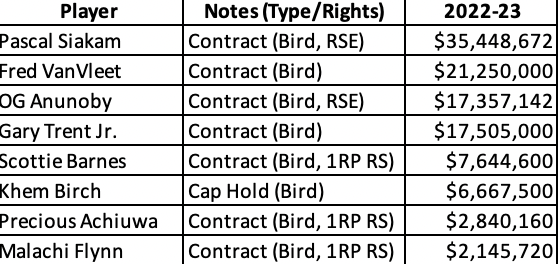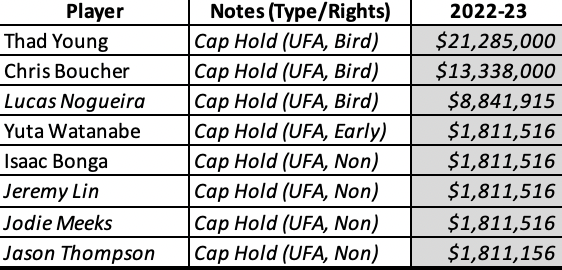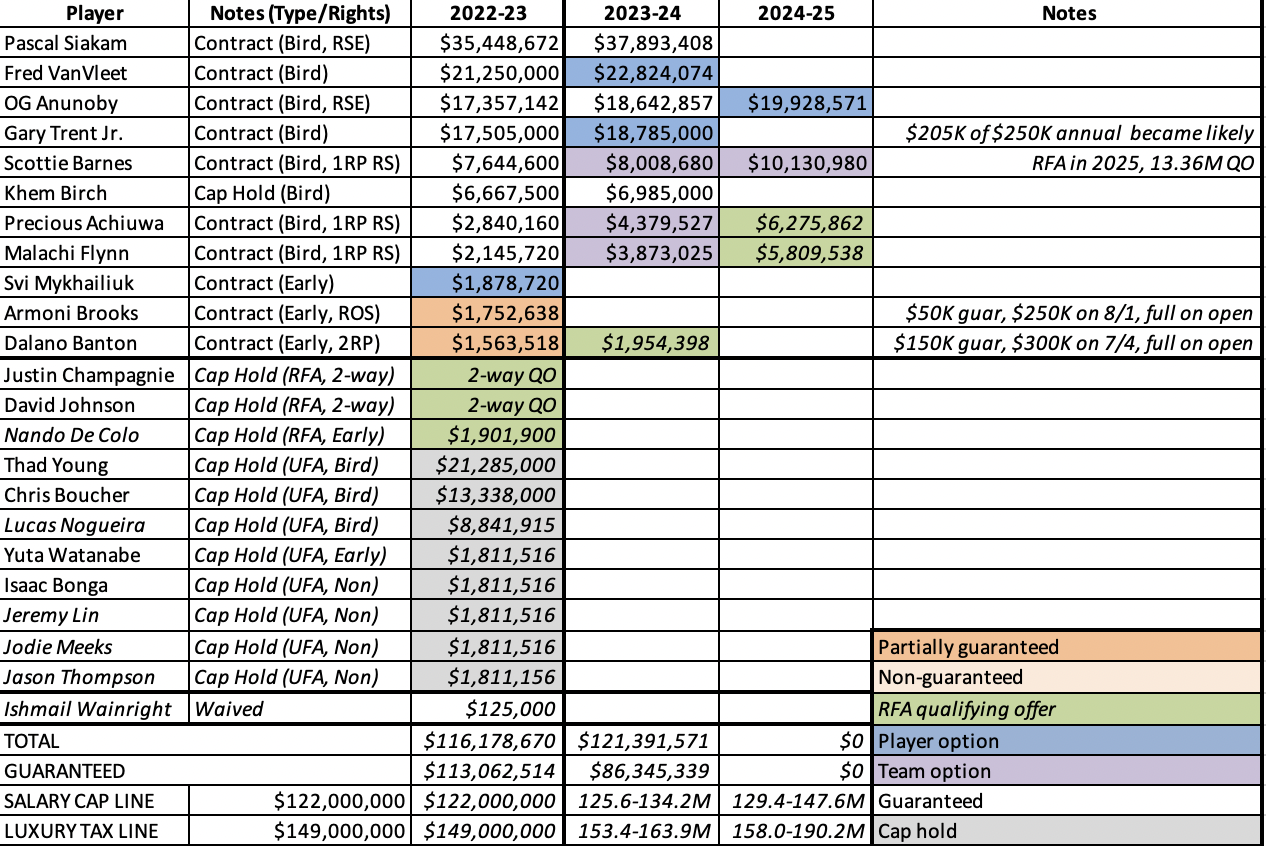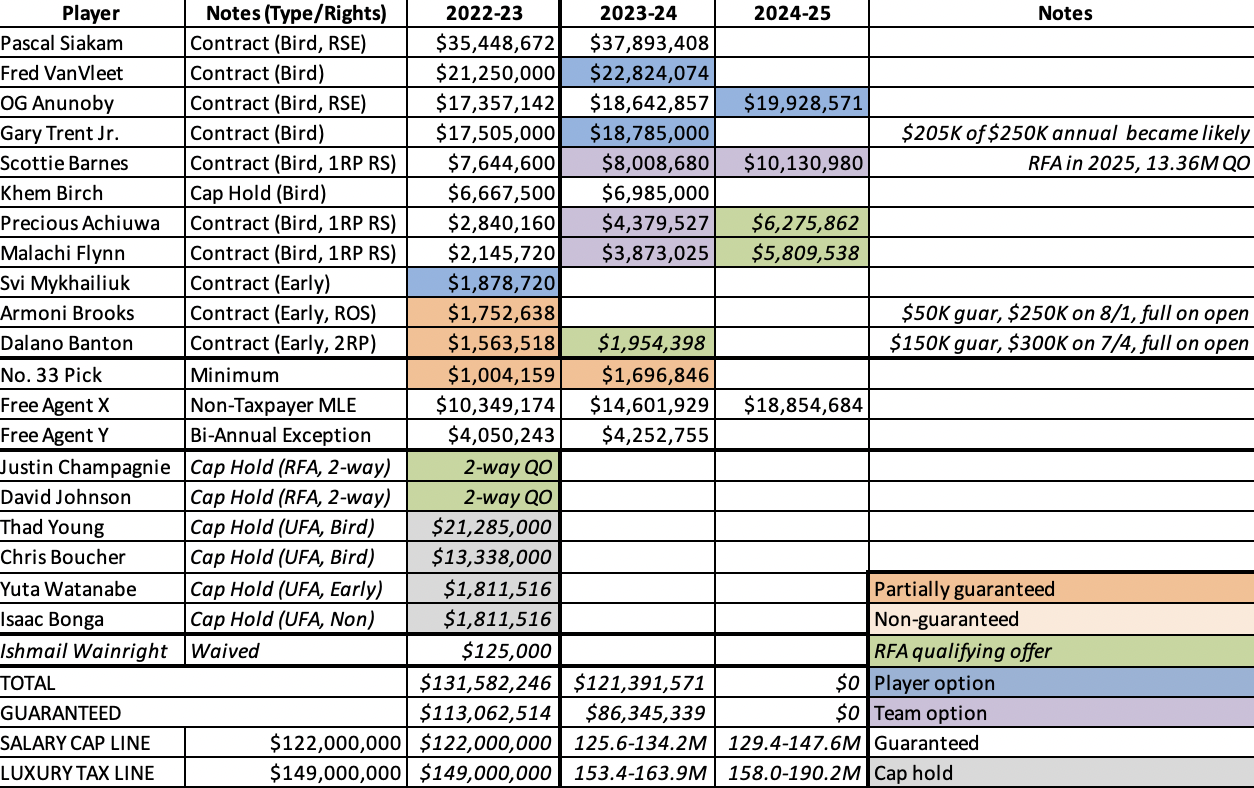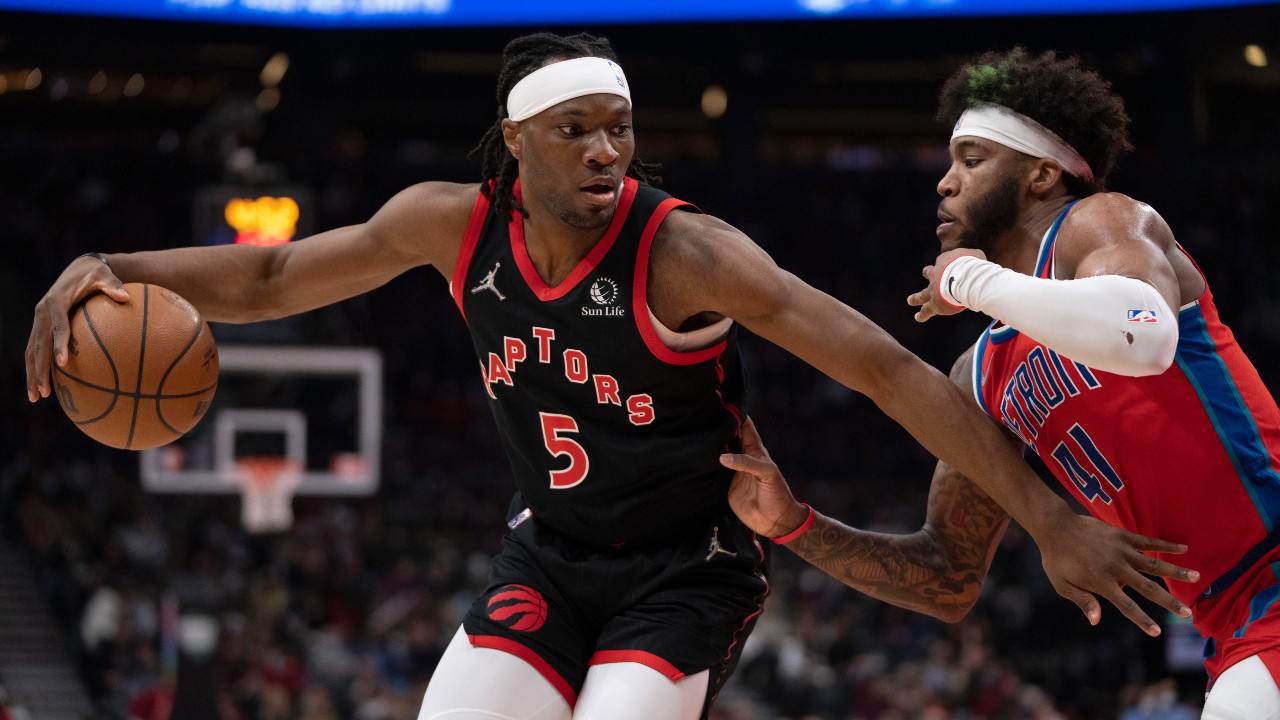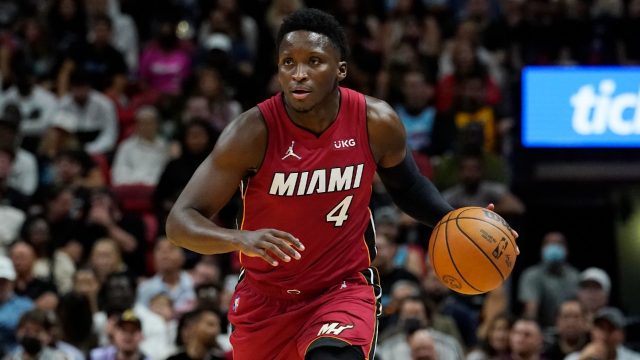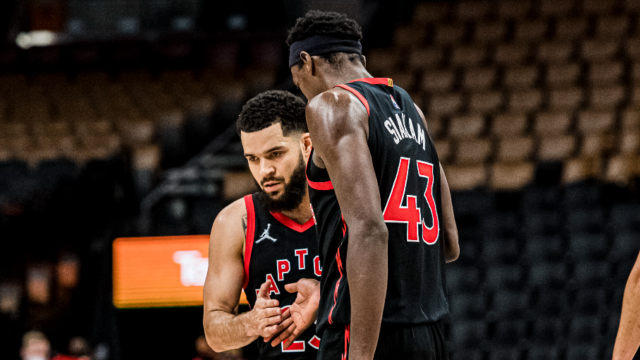Of course, I had to come back for this annual deep dive. It is Year 11 of this primer, and that is by far my healthiest relationship, so let’s sustain it.
This figures to be a pretty straightforward offseason for the Toronto Raptors, albeit a less exciting one. They have only a couple of paths to improving unless they decide to make a pretty big trade at some point. We’ll get into those specifics as the summer rolls on. For now, bookmark this page for when uncertainty arises around offseason rules and scenarios.
Note: All of the exception amounts and assumptions within are based on the league’s latest reporting and general industry assumptions. All of the analysis will remain the same wherever the exact totals land, but for right now we’re working with an assumed cap of $122 million and an assumed luxury tax line of $149 million.
The current cap sheet
This is what my Raptors cap sheet for the offseason currently looks like:
And that graphic right there is why we break this down into smaller sections.
Contracts, holds, and explanations
Contracts
The Raptors have the following guaranteed contracts on their books for 2022-23:
This is the straightforward part. Those eight players make up the core the team will carry into the summer. They also make up most of the team’s salary cap space, as they are owed a combined $110.9 million.
Options
Svi Mykhailiuk somewhat inexplicably holds a player option for $1.88 million.
Coming off a year in which he struggled as a shooter and fell out of the rotation, it seems likely he’ll pick that option up and be back on that minimum contract. The choice here for Mykhailiuk is whether that full guarantee is worth another year possibly spent deep on the bench. If he were to bet on himself and look for employment elsewhere, his minimum salary would jump to $1.94 million, but it’s hard to imagine him getting a full guarantee in a fresh situation.
Non- or partially guaranteed deals
The Raptors have the following non- or partially guaranteed deals:
Armoni Brooks and Dalano Banton are both signed to The Tolzman Special — two-year deals with a full (or at least hefty) guarantee in year one and escalating guarantee triggers in year two. Basically, the Raptors provide these fringe players with a bit of security, then have multiple points during the offseason in which they can effectively pay for a longer look or cut bait.
Brooks is guaranteed $50,000 right now, $250,000 if he’s on the roster past Aug. 1, and his full contract if he makes the opening day roster. Banton is guaranteed $150,000 right now, $300,000 if he’s on the roster past July 4 — a player-friendly pre-Summer League trigger — and his full contract if he makes the opening day roster.
Unrestricted free agents
The Raptors have the following unrestricted free agents, with their cap holds in grey:
Every free agent carries a “cap hold” on the books. This is an artificial charge against the salary cap that is determined by the player’s previous salary. These holds exist to prevent a team from going below the cap, signing free agents, then using rights to re-sign their own players.
Effectively, teams have to renounce their rights on a player — and the ability to re-sign them beyond the cap — to clear their hold off the books. Say, for example, the Raptors wanted to create cap space this summer to chase a big free agent. They would have to rescind all of these rights to remove the holds off their books. They then wouldn’t hold Bird rights on Chris Boucher and Thaddeus Young, so they couldn’t then exceed the cap to re-sign them.
Full Bird rights allow a team to exceed the salary cap to re-sign their own player up to the maximum contract amount. Early Bird rights also allow a team to exceed the cap to re-sign their own player, but only up to 175 per cent of his previous salary or 105 per cent of the league average salary the prior year, whichever is larger. Non-Bird rights cap that number at 120 per cent of the minimum salary.
Some years, the decision of whether to be an above- or below-cap team is difficult, as you trade in some exceptions and rights to maximize cap space for a free agent, or sacrifice free agent spending power to better retain your own players. In a below-cap year, the Raptors could easily discard of the rights to players like Lucas Nogueira, who really only remain there as an accounting wrinkle. Players like Boucher and Young make those decisions tougher.
Restricted free agents
The Raptors have the following restricted free agents, with their qualifying offers in green.
Restricted free agency allows a team to match an offer sheet that a free agent signs with another team. To hold those rights, the Raptors have to tender those RFAs a qualifying offer. It’s a small risk, since the player could sign the qualifying offer and you’d owe them the guaranteed amount, but the Raptors don’t have to worry much about that here. Those qualifying offers carry cap holds, as well.
Rights apply in the same way to RFAs as explained above for UFAs, with some additional wrinkles that won’t be a factor for Toronto this offseason, so we won’t bother getting into them.
The two-way qualifying offer is just another two-way contract with $50,000 guaranteed, so there’s very little risk in holding Justin Champagnie and David Johnson as RFAs while they work through the summer development program. If another team is interested, the Raptors could let them go, or match a salary up to the non-taxpayer mid-level exception for them.
And yes, that’s Nando De Colo. In a move that I have to assume is just for me at this point, the Raptors continue to tender De Colo qualifying offers to retain his rights, even though he’s 34 and hasn’t shown a ton of interest in an NBA return. There is a light that never goes out. There is no real cost to the Raptors qualifying De Colo and sitting on his rights unless they operate as a below-cap team, in which case they’ll finally renounce him and I will be in tears.
Unlike some other sports, NBA teams do not receive compensation for losing their RFAs to other teams.
Note: The Raptors will still hold rights on Jalen Harris if he is reinstated by the NBA at any point. For now, he is off the books while he remains disqualified by the league.
Draft picks and draft rights
The Raptors hold the No. 33 pick in the NBA Draft, which was originally Detroit’s pick, received via San Antonio in the Young trade. The Raptors do not own their first-round pick due to that same trade, and do not own their own second-round pick due to a 2019 tax-saving move to dump Malachi Richardson on the 76ers (the pick now belongs to Golden State).
The No. 33 pick is not subject to the “rookie scale” for first-round picks, so the Raptors are free to negotiate any deal with that pick, within the regular CBA rules. That can sometimes be a two-way contract (Johnson), a two-year minimum (Banton), or, if the team wants to use a chunk of one of their exceptions, a three- or four-year minimum (Norman Powell).
Second-round picks also don’t carry a cap hold, and their minimum salary for the purposes of the luxury tax line is less than that of other minimum-salaried free agents.
In the event a pick isn’t going to sign a deal with the Raptors this year, the team still needs to submit what’s called a “required tender” to maintain his draft rights. The required tender is a one-year, non-guaranteed contract for the league minimum. In most cases, it’s submitted and the player doesn’t sign it, and the team then holds the player’s NBA rights for whenever they come back from overseas (or the G League).
There are instances where a player will sign the required tender, essentially daring the team to cut him (making him a free agent) or keep him on the roster. When a Fred VanVleet or Terence Davis II suggests a team not draft them in the second round so they can dictate their destination, it’s that required tender that they’re implicitly threatening to sign.
The Raptors also still hold the draft rights to DeeAndre Hulett, which, because of an amusing wrinkle in how trades work, could still technically be traded.
Two-ways, Exhibit 10s, and summer contracts
The Raptors don’t currently have any players on this type of deal. I mention it because a handful of post-draft and late-free agency deals will be reported as “signings” when they’re really closer to tryout deals.
Two-way roster slots should be familiar by now, though the rules and limits have changed year-to-year. Exhibit 10 contracts refer to non-guaranteed minimums that contain the right for the team to convert the player to a two-way contract, keep them on an NBA minimum, or, if the player is willing, waive them and provide them a bonus as a supplement to the G League salary if they stay with Raptors 905 long enough.
Teams can have up to 20 players on their roster in the offseason. These two-ways, Exhibit 10s, and summer contracts don’t carry a cap or tax hit unless the player makes the main roster, but they do take up one of those 20 spots. (Teams can have up to two two-ways and six Exhibit 10 players at a given time.)
Dead salary
The Raptors still owe Ishmail Wainright $125,000 for 2022-23 that will count against the cap and tax. He signed a two-year deal last summer with multiple guarantees, and the Raptors are still on the hook for that even though he landed in Phoenix.
Freddie Gillespie, Sam Dekker and Drew Eubanks, who all carried 2021-22 cap hits, are no longer on the books.
The big picture
Let’s double back to our original image now that I’ve explained most of it.
Over the coming weeks, we’ll use this primer as a baseline for analyzing different scenarios. It’s too much to go into each pathway here. Having said that, we can simplify what we’re looking at.
Here, let’s remove all of the cap holds from our actual salary calculation. Those still exist in reality, but for practical purposes, the Raptors don’t have to concern themselves with them.
That’s because the Raptors will almost certainly operate as an over-cap team. Take a look at the guaranteed contracts again. That $110.9 million for eight players would leave the team with $11.1 million in estimated cap space, and that’s before adding incomplete roster charges for the requisite empty roster spots. The Raptors would have to renounce a lot of rights, waive non-guaranteed players, and unload additional salary just to have a free agent conversation that extends beyond the mid-level exception. That’s just not worth it with this free agent class. Plus, as we’ll see, staying above the cap has some marginal advantages.
Let’s further simplify by adding the No. 33 pick and the relevant exceptions and removing the free agents who are dormant.
What this shows us is that if the Raptors sign their second-round pick to the minimum and use the full MLE and BAE, they’d be at $131.6 million committed to 14 players. That’s a pretty good spot to be in, leaving them their two two-way slots and a 15th actual roster spot to retain one of Boucher or Young.
There are also scenarios where you move the second-round pick for a two-way player, leaving an extra roster spot for a camp battle or Champagnie or an undrafted free agent. Extend this further, and the Raptors could decline to use the bi-annual exception (thus saving it for next summer), retain Boucher and Young both, and fill the roster out with young roster battle contenders.
Here's how that last example might look in practice:
This is the Raptors running it back with Boucher and Young making a combined $15 million, the full mid-level being used, Champagnie being signed to the minimum, and a number of minimum-salaried guys battling for a roster spot or two-way. The team could make those moves and stay beneath the luxury tax. Realistically, they could go as high as $18 million combined for Boucher and Young and still be comfortable with the MLE and tax line.
That's not bad, there’s just no real path to adding beyond the mid-level amount.
Luxury tax
Luxury tax is charged on an escalating marginal basis, such that the first $4,999,999 is taxed at $1.50 per dollar, and the tax increases for each subsequent $5-million block. It’s basically an escalating penalty the further over the tax you go, to where the deeper into the tax you are, the greater benefit there is to trimming each dollar.
The Raptors have shown a willingness to spend into the tax when the contention window is open but have also tip-toed underneath it where possible. This doesn’t seem like a tax year for them unless a major trade materializes.
Luxury tax apron
There is also something called the luxury tax “apron” to consider. The tax apron is like a sort-of third line of salary demarcation after the salary cap and luxury tax lines. If a team crosses the apron — which is projected to be $155.7million under current assumptions — then they lose some roster-building options that other teams have. (That includes sign-and-trade options, the BAE, a different MLE, and more, as well as a hard cap.)
Exceptions
In addition to the non-taxpayer mid-level exception and bi-annual exception the Raptors will likely have available, teams can always sign players to the minimum if they have roster space (unless they’re hard-capped by the apron).
Here are the different options the Raptors face:
Get under cap
Cap space: Depends on how many free agents they lose/renounce; the theoretical max is not worthwhile at $10.8 million (before any trades).
Room mid-level exception: $5.33 million (one- or two-year deals with a five per cent raise; can be split between players)
Stay above cap, below tax apron
Cap space: $0
Non-taxpayer mid-level exception: $10.34 million (up to a four-year deal, with raises of five per cent of the first-year salary; can be split between players)
Bi-annual exception: $4.05 million (up to a two-year deal, with a five per cent raise; can be split between players; if used, is unavailable for 2023-24)
Stay above cap, reach tax apron
Cap space: $0
Taxpayer mid-level exception: $6.39 million (up to a three-year deal, with raises of five per cent of the first-year salary; can be split between players)
You see why I’m so confident the Raptors will work in the “stay above cap, below tax apron” range given those options.
Trade Exceptions
The Raptors also hold two traded player exceptions. These can be used to take back a contract without matching salary. The important note here is that exceptions cannot be combined with each other, with other exceptions, or with players; they are stand-alone tools.
Toronto’s TPEs are worth $5.25 million (from the Goran Dragic trade, good until Feb. 10) and $3.07 million (from the Kyle Lowry trade, good until Aug. 6).
Trade rules
The rules for trades work the same as they do in-season (see here), just with more wrinkles due to teams having cap space, the potential for sign-and-trades, and more. With the Raptors operating as a non-tax team, they’ll be subject to the following salary restrictions:
Outgoing salary under $6.5M: 175 per cent of outgoing salary, plus $100,000
Outgoing salary $6.5-19.6M: Outgoing salary, plus $5 million
Outgoing salary over $19.6M: 125 per cent of outgoing salary, plus $100,000
Being a below-tax team also allows the Raptors to acquire players via sign-and-trade, if they’re willing to accept being hard-capped at the apron amount. (It’s hard to envision a scenario where the Raptors have to worry about the apron.)
Sign-and-trade
A sign-and-trade deal can help a player get to a preferred landing spot even if that team doesn’t have enough cap space. The Lowry example remains fresh, where the Raptors’ willingness to sign-and-trade Lowry allowed him to earn more money than Miami could have otherwise offered without cutting a number of players. The Raptors picked up Precious Achiuwa (and, later, Young, via Dragic) for their trouble.
This could be a heavy sign-and-trade year because so few teams have traditional cap space. Sign-and-trading a free agent can help that player earn beyond the mid-level amount, help a team acquire a player they otherwise couldn’t, and help the team losing the player recoup an asset.
Sign-and-trade deals must be for at least three years, though only the first year has to be guaranteed. This is worth keeping in mind with Young’s Bird rights, as a move where the Raptors sign him to a number just to help make cap math work has to pay Young in full for at least one year.
Assets
Picks: The Raptors own the No. 33 pick this year, all of their second-round picks moving forward except 2024, and all of their first-round picks from 2023 onward. They cannot trade their 2023 first-round pick until after draft night, however, due to a rule that prohibits dealing consecutive future first-rounders.
Rights: Free agent rights cannot be traded. The Raptors can deal Hulett’s rights.
Cash: The league allows teams to send out and receive up to a certain amount of cash in aggregate each cap year. The Raptors can still send and/or receive up to $5.79 million for the 2021-22 league year. That number resets and bumps to $6.28 million on July 1. Cash in trades does not count for salary matching.
Extensions
VanVleet and Pascal Siakam are both eligible for an extension this summer. Unfortunately, the rules around veteran extensions are fairly limiting, so the sides will have to reach common ground within narrow constraints.
For VanVleet, there are two approaches. He could opt in to his 2023-24 salary at $22.8 million, then sign an extension for up to three years and up to $88.7 million. He could also decline that option, then sign an extension for up to four years and $114.2 million. The second option actually pays VanVleet more, but that’s under the not-so-safe assumption the Raptors are willing to give him the biggest extension they can. Either deal would take him to the summer of 2027, when he’ll be 33. Without an extension, he’ll likely opt out and become a free agent in 2023.
Siakam’s situation is a bit clearer because he’s a max-contract player. Once Oct. 1 rolls around, he can sign an extension for up to three years and $128.9 million. Siakam doesn’t hold a player option, so there’s no risk of him hitting free agency until 2024, even without an extension.
Key decisions
Player option: Mykhailiuk has until June 22 to exercise his 2022-23 player option.
NBA Draft: No. 33 pick in Round 2 of the draft on June 23.
RFA qualifying offers: Qualifying offers to pending RFAs must be submitted by June 29.
Team option: The Raptors have no team options for this summer. They will have to make rookie-scale option decisions on a number of players in the fall.
Free agency: July 1 chaos, baby.
Guarantees: Banton (July 4) and Brooks (Aug. 1) have contracts with guarantees that escalate midway through the offseason and again at the beginning of the regular season.
Extensions: VanVleet eligible July 8, Siakam eligible Oct. 1.
Wrap
While dense, this document is intended as a reference you can come back to throughout the offseason. The hope is to create a knowledge base of the whys and hows of the months ahead. We’ll revisit as necessary as actual transactions occur.
The key takeaway here is this: Run it back, use the mid-level, retain Boucher and/or Young, and fill the roster with more young camp competition guys. Barring a trade, that’s what the Raptors’ offseason looks like.

